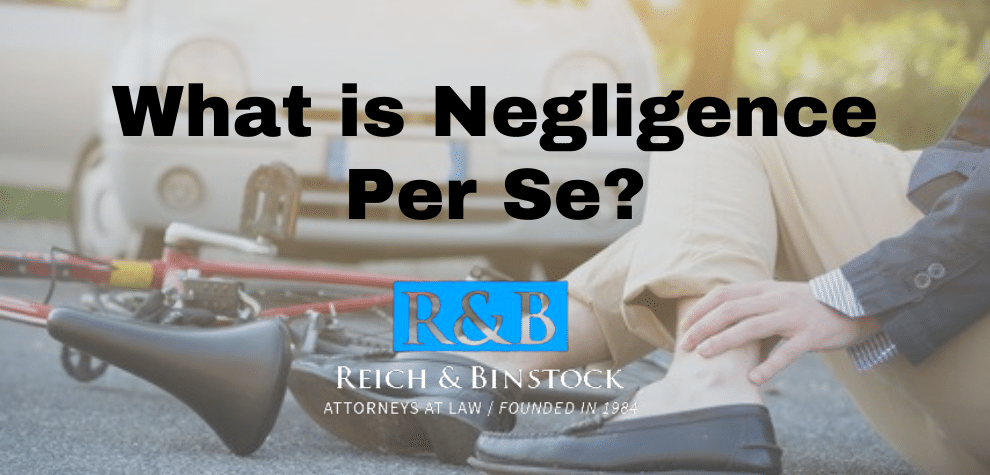According to the CDC, there are approximately 39.5 million doctor’s office visits in the U.S. due to unintentional injuries. Additionally, there are 29.4 million annual ER visits in the U.S. due to unintentional injuries. Sadly, unintentional injuries lead to approximately 170,000 American deaths a year. Some of these injuries and deaths fall under the well-known legal term called negligence. But what is negligence per se? Is there a difference between the two legal theories?
Houston personal injury lawyers at Reich & Binstock want to examine the details of your case and help you answer the same question: what is negligence per se? And does my case fall into that category? Call us today at 713-622-7271 for a free consultation.
Negligence vs Negligence Per Se
Negligence and negligence per se may sound like the exact same thing because they’re often referred to as personal injury cases, but they are completely separate legal theories. Specifically, negligence is a failure to take appropriate care of someone that ultimately results in injury or death.
To win a negligence lawsuit, plaintiffs must prove:
- That the defendant owed the plaintiff a standard of care
- The defendant breaches duty of care
- The plaintiff suffered an injury due to the breached standard of care
But what is negligence per se? It’s the failure to take care of someone by violating a statute or regulation without an excuse. However, a safety statute only applies if it’s supposed to protect the class that the plaintiff belongs in and if it’s supposed to protect the plaintiff from harm. For example, an electricity-related safety regulation exists to protect against workplace injury. If the electricity harms a passerby instead of an employee, this case may not have basis for a negligence per se lawsuit.
A different type of negligence is prima facie negligence. Keep in mind that many different types of negligence exist, and it is important to understand the different ways in which they can affect a case.
Examples of Negligence Per Se
Specific examples of negligence per se include:
- When someone causes a Houston car accident from speeding or running a red light
- A driver hits another car while their blood alcohol content is over the legal limit
- Blocking a roadway
- Driving on the left side of the road
- Street racing
- When a product wasn’t manufactured according to federal regulations and causes significant injury or illness to the consumer. In other words, it was a defective product.
- Someone is severely injured because a building isn’t built to code. In this case, you may need a construction accident lawyer Houston.
Limitations of Negligence Per Se
Even if a defendant’s actions sound logical in a negligence per se lawsuit, that doesn’t always excuse them or their actions. However, there are some legitimate excuses when it comes to negligence per se, including:
- Incapacity made it reasonable for a defendant to violate the statute
- The defendant wasn’t aware (and shouldn’t have been aware) of the need for compliance
- Even while using reasonable care, the defendant was unable to comply
- The defendant experiences an emergency that wasn’t related to their misconduct
- Compliance would have put the defendant and others at greater danger of harm
Why Does Negligence Per Se Matter?
Now that we know what is negligence per se, the new question is: why does it matter? Unlike a typical negligence case which leaves room for ambiguity among a jury, negligence per se is generally a yes-or-no question.
This is because at the end of a trial, a jury receives a document called a jury charge which asks the members to collectively answer case questions. For example, in an ordinary negligence case, the jury may answer something like: “do you find the defendant, John Doe, negligent?” Questions like this can be very vague, leaving lots of room for personal opinion. Meanwhile, a jury may answer something like this in a negligence per se case: “Did the defendant, John Doe, run a red light?” Because this is a very black-and-white question, it leaves no room for personal opinion.
How Does the Court Determine What Is Negligence Per Se?
It’s ultimately up to the court to determine if a personal injury case classifies as negligence per se. So how is negligence per se proven and determined in court? Plaintiffs must show:
- The defendant violated a statute that exists for the sake of safety
- A statute violation results in an injury
- Someone’s actions caused the injury that the statute exists to prevent
- The plaintiff was a member of the statute’s protected class
The first two bullets are usually determined by a jury to be undeniably factual. Meanwhile, a judge decides whether the last two bullets are a matter of law.
What Do I Need to Prove in a Texas Personal Injury Case?
Personal injury cases can be either negligence or negligence per se, depending on if a statute violation caused the injury. Personal injury cases don’t involve government prosecution unlike criminal cases. Instead, the injured person will seek compensation from a person or a business who allegedly caused the injury. Personal injury claims can be the result of accidents and intentional acts. The most common types of personal injury claims include:
- Car accidents
- Trucking accidents
- Workplace accidents
- Slip and fall accidents, also known as premises liability
- Medical malpractice
- Dog bites
- Assaults
- Careless or inadequate security
- Child injuries
- Child abuse
- Child sexual abuse
- Wrongful death
When it comes to actually winning a negligence per se lawsuit, a plaintiff must prove all the necessary elements. These elements include duty of care, breach of duty, chain of causation, and damages.
Duty of Care
The outcome of some negligence per se lawsuits depends on whether the defendant owed a duty of care to the plaintiff to begin with. As shown above, a passerby who suffered an electricity-related injury by a workplace with specific electricity regulations wouldn’t have a successful negligence per se case. This is because the passerby wasn’t a member of the statute’s protected class.
Breach of Duty
A plaintiff can prove the duty of care element, but that alone isn’t enough. It’s crucial that the plaintiff and a personal injury lawyer proves that the negligent party breached their duty. In other words, the negligent party either failed to exercise reasonable care or they purposely violated a safety regulation.
Causation
There are two types of causation in a negligence per se case: cause in fact and proximate cause.
Cause in Fact
A plaintiff must prove that the defendant’s actions or violations actually caused an injury. Cause in fact is also known as “but-for” causation. This means that the plaintiff’s injury wouldn’t have happened if it hadn’t been for the defendant’s actions.
Proximate Cause
Meanwhile, proximate cause refers to a defendant only being responsible for harm that they could’ve expected through their actions. Basically, if a defendant caused injuries that they couldn’t expect, then the plaintiff can’t prove that the defendant’s actions ultimately caused the plaintiff’s injuries.
Damages
It’s not enough to prove that the defendant failed to take care of their plaintiff. Their failure must have caused actual damages, such as severe injury, illness, or even death. The plaintiff must prove actual damages in a negligence per se case.
Texas’ Shared Fault Rule
In Texas specifically, the shared fault rule can further complicate negligence cases. This rule specifically states that if a person or a business is partially responsible for an injury, then they too are responsible for damages. The shared fault rule specifically comes into play when multiple parties contributed to a plaintiff’s injuries. In a case like this, the court will assign each party a percentage of fault based on how much responsibility they bear in a person’s injury. When a victim receives damages, each party will then pay a percentage of a person’s total recovery.
Does Negligence Per Se Have Harsher Penalties?
The penalties for both negligence and negligence per se are largely the same. Depending on the details of the case, a Texas defendant can serve jail time and award punitive damages to the plaintiff.
What Kind of Damages Can I Recover in a Negligence Per Se Case?
In Texas specifically, there is a negligence rule called the 51% bar. The rule states that if a plaintiff was 51% or more at fault for their injury, they won’t receive compensation. But there are a couple types of compensation victims can recover if that rule works in their favor: economic and non-economic damages.
Economic Damages
The most common examples of economic damages sought in a personal injury case include medical expenses and lost wages. Plaintiffs can receive compensation for:
- Doctor appointments
- Hospital stays
- Emergency room treatment
- Ambulance fees
- Nursing services
- Medication costs
- MRI’s, X-rays, and other scans
- Surgery
- Rehabilitation and physical therapy
- Future medical treatment
However, to recover economic damages, a plaintiff must prove that all expenses are directly related to the injury caused by the defendant.
Meanwhile, economic damages for lost wages represents the money someone would’ve earned during their injury. Plaintiffs can also recover loss of earning capacity if they receive a long-term disability from their injury. Aside from how much income victims lose from their injuries, they may also claim:
- A promotion or wage increase that you were due while out of work
- Loss of commission from sales
- Bonuses that you were previously paid and that you were on track to receive before your injury
- Loss of fringe benefits
- No pension benefits
Non-Economic Damages
Non-economic damages are those that don’t have a set monetary value. Some of the most common examples of non-economic damages include:
- Pain and suffering
- No enjoyment in day-to-day life
- Emotional distress due to injuries, such as anxiety, depression, or sleep loss
- Loss of consortium, or loss of companionship, which is usually applied to wrongful death lawsuits
Statute of Limitations for Filing a Personal Injury Claim in Texas
In the state of Texas, negligence per se victims have two years from the date of their injury to file a claim. However if the victim is a minor at the time of their injury, the medical malpractice statute of limitations in Texas is extended. Once a negligence per se victim turns 18, they have two years to file a claim. The two year rule applies for all personal injury claims including medical malpractice, product liability, assault and battery, and wrongful death.
Contact a Houston Personal Injury Attorney Today
If you or a loved one suffered a severe injury due to negligence per se, personal injury lawyers at Reich & Binstock want to make sure you receive justice. We have long-term experience with negligence cases that often result in a favorable outcome for the victim. Call us today at 713-622-7271 for a free consultation.














